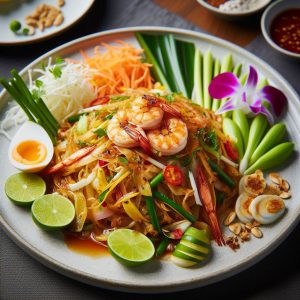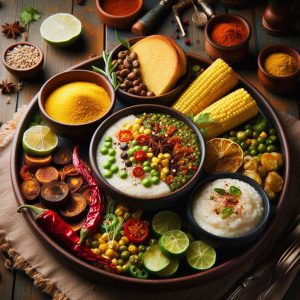Cultural Fusion in AI Image Generation
I tested three different culinary fusion prompts with an AI image generator to analyze how it combines different food traditions.
For my first prompt, I asked for “pad Thai plated at a three Michelin star Western restaurant with French techniques.” I was expecting something along the lines of micro food, slow food movement aesthetics, or maybe a deconstructed pad Thai with nitrogen infusion–you know, the works. Instead, I got a regular old-looking pad Thai with some vegetables arranged around the side of the plate. Nothing about it screamed “three Michelin stars” or “French techniques.” It was just… pad Thai.

This made me wonder if the AI isn’t really that good at handling hybrid concepts. It seems to grab onto the main food item–pad Thai–and then just adds a few decorative elements around it rather than truly transforming the dish as requested.
My second experiment was “South American grits and cornbread reimagined with Indian spices and presentation style.” The result was a total smorgasbord–lots of color, lots of spices, lots of different elements arranged on the plate. The cornbread was only a tiny piece of the ensemble, and one of the side bowls had what looked like a pile of orange spice (probably meant to be turmeric). The center bowl was actually divided in half with grits on one side and what looked like lentils on the other – this was the most creative element of the dish. Oddly enough, there was another separate bowl that also contained grits at the side. What caught my eye were strips of raw corn arranged on the plate and off the plate surrounding were small clay containers of spices and then a random half lime just sitting there.
The AI seemed to be following a “more is more” principle, throwing in limes and chilis and all sorts of elements, but it completely failed to integrate these things together. Instead of reimagining Southern staples with Indian influences, it just placed traditional versions next to Indian elements.

My final test was “Japanese sushi prepared with Mexican ingredients and presentation.” Again, the results were uninspiring–it looked like regular sushi with nothing that screamed “Mexican.” The wasabi was arranged in artful dollops, and there was a prawn head decoratively placed along with other unrecognizable garnish items behind the sushi, and also poking out from behind this wall of ancillary items, another piece of sushi. There was a separate clay kind of mini trough behind the main plate, very deemphasized, with very finely sliced chilis–the only remotely Mexican element, but it was barely noticeable. The maki in the center looked pretty unappetizing with little orange maggoty things spilling out from under the seaweed casing, and these certainly weren’t recognizable Mexican ingredients.

What became clear is that these AI systems struggle with true fusion. They can recognize “pad Thai” and “sushi” as concepts, but when asked to transform them through the lens of another culinary tradition, they fall short. Instead of reimagining dishes, they just place elements from different cuisines side by side–an additive rather than transformative approach to fusion.
It looks like when the AI sees “pad Thai” or “sushi” in a prompt, that’s what it focuses on, and everything else just becomes window dressing. The French techniques or Mexican influences barely show up. I’m guessing the AI was probably trained on tons of regular food photos – like thousands of pictures of normal pad Thai – but not many examples of actual fusion cuisine. So when I ask for something more creative and out-of-the-box, it just defaults to what it knows best and throws in a few random elements from the second cuisine as an afterthought.
I noticed the AI went overboard with the Southern-Indian fusion attempt. Instead of blending the two styles together, it just piled up a bunch of separate elements on the same plate. Grits here, spices there, cornbread off to the side. It’s like the AI only knows these cuisines as lists of ingredients rather than as cooking styles that could actually mix together in interesting ways.
What struck me most was how conventional all three images were, despite my explicitly asking for fusion. The pad Thai remained just pad Thai, the grits and cornbread stayed recognizably Southern with Indian items merely alongside them, and the sushi showed no Mexican influence whatsoever. It’s as if the AI has a hard time breaking out of established categories to create something truly innovative–exactly the kind of creative leap that defines real culinary fusion.
A pattern emerged across all three images: the AI relied heavily on decorative garnishes and artistic presentation to create the impression of sophistication rather than actually reimagining the dishes themselves. The prawn head in the sushi image was never meant to be eaten—it was purely decorative, like the scattered vegetables around the pad Thai or the raw corn strips with the grits. These exterior elements seemed to compensate for the lack of imagination in the edible components. The AI appeared to understand “fancy food” as “regular food with artistic garnishes” rather than genuinely innovative fusion cuisine.
This experiment got me thinking about what these image generators can and can’t do yet. The AI made some decent-looking food pictures, but it seemed to miss what I thought I was asking for. I’m no expert on fusion cuisine, but even I know it’s supposed to be more than just putting a bowl of grits next to some Indian spices. I expected the AI to blend things together more – not just place different foods side by side. Maybe these systems just haven’t seen enough examples of real fusion cooking, or maybe they’re just not designed to mix concepts in that way. Either way, I found the results pretty revealing about current limitations.